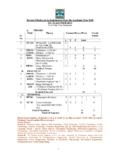Transcription of AGC Total Knee System - Biomet
1 AGC Total knee SystemConcise Surgical Technique FeaturingEquiFlex InstrumentationConcise Surgical TechniqueFeaturing EquiFlex AGC Total knee SYSTEMC oncise Surgical Technique Featuring EquiFlex InstrumentationDisclaimerThis brochure provides a description of the surgical technique used by Iain C. Lennox, MD FRCS for informational purposes only. Biomet UK Ltd., as the manufacturer of this device, does not practice medicine and does not recommend any particular surgical technique for use on a specific patient. The surgeon who performs any implant procedure is responsible for determining and utilising the appropriate techniques for implanting prosthesis in each individual UK Ltd, is not responsible for selection of the appropriate surgical technique, nor does it advocate a particular technique to be utilised on an individual is a registered trademark of Biomet UK Ltd.
2 Biomet UK Ltd 2006 Concise Surgical TechniqueFeaturing EquiFlex Contents Introduction Principles of Ligamentous Release Surgical Approach Surgical Technique 1. Proximal Tibial Resection2. Preparing the Intramedullary Canal3. Setting the Valgus Angle4. Distal Femoral Resection5. Establishing the Extension Gap6. Establishing the Flexion Gap7. Adjusting the Femoral Cutting Block Position8. Femoral Resection9. Femoral Component Trial10. Determining the Tibial Component Size & Alignment11. Preparing the Tibial Plateau 12. Final Trial Reduction13. Cementing the Components14.
3 Component List15. knee Instrument Kit ListingConcise Surgical TechniqueFeaturing EquiFlex EquiFlex IntroductionThe AGC Concise instrumentation featuring EquiFlex ligament balancing is designed to ensure that the Total knee replacement is appropriately balanced to ensure stability and durability. The knee is balanced in extension first, where the majority of loading occurs. Balancing the knee in flexion follows to ensure that the ligaments will set correct femoral external rotation and correct patella tracking. This method will result in an equal quadrilateral extension and flexion gap.
4 The EquiFlex instrumentation simplifies the process of soft tissue of Ligamentous ReleaseThe AGC Concise instrumentation , featuring EquiFlex is designed for use with the AGC Posterior Cruciate Retaining Total just 4 instrument trays, the System represents a significant advance in instrument management for the modern operating Total knee InstrumentationFor the AGC Total knee Replacement Cruciate Retaining Concise Surgical TechniqueFeaturing EquiFlex Surgical Approach The patient is placed supine on the operating table with a lateral support next to their tourniquet and a sandbag under the foot so that the knee will support itself when flexed.
5 The leg is elevated, the skin prepared, and the tourniquet inflated. An incision should be made from the mid line from the superior pole of the patella to the inferior aspect of the tibial tuberosity. Skin should be retracted superiorly and the quadriceps tendon incised 1 cm above the patella on the medial side with the incision extending medial to the tibial tuberosity. From the mid line, the periosteum is released for a few millimetres around both sides of the knee as far back as possible. The fat pad should be excised completely and for a few millimetres.
6 Large osteophytes on the tibia should be removed. The anterior cruciate ligament should be removed with sharp dissection, where it can be seen. The patella should be everted and osteophytes around the patella Surgical TechniqueFeaturing EquiFlex Fig 1 Fig 3 Concise Surgical Technique Featuring EquiFlex Ligament Balancing InstrumentationStep 1 - Proximal Tibial ResectionResection should be perpendicular to the mechanical axis and is accomplished using an extra-medullary surgical technique. The EM resecting guide will produce a neutral or perpendicular resection in coronal and sagittal planes.
7 Place the leg in 90 of flexion. Secure the ankle clamp to the inferior end of the EM resecting guide with the ankle clamp in the correct orientation for left or right. Place the ankle clamp centrally on the ankle and secure. Align the shaft of the EM resecting guide with the medial third of tibial tubercle. (Fig 1) Sublux the tibia forward allowing the femur to fall behind. The remaining cartilage and anterior cruciate ligament can now be excised. Attach the tibial cutting block to the top of the tibial resector using the locating screw. Screw the stylus into the top of the tibial cutting guide.
8 (Fig 2) The resection level is estimated using the stylus. (Fig 2) 10mm from an undamaged plateau or 2mm from the most worn side. Clamp the EM guide using the thumbscrew and pin the tibial cutting block in place through the lowest holes using bone nails or quick release drills. Remove the stylus. Use a Saw Blade to resect the tibial plateau through the slot. (Fig 3) Remove the tibial resection 2 Concise Surgical TechniqueFeaturing EquiFlex Note: If additional bone removal is necessary, place the block over the pins using the upper holes to remove an extra 2mm of bone.
9 The slope of the resected surfaces can be checked by inserting an E/M rod through the holes in the universal handle and tibial template assembly. (Fig 4)Step 2 - Preparing the Femoral Intramedullary Canal Use the 9mm diameter femoral drill to make a hole in the centre of the intercondylar notch approximately 1cm anterior to the emergence of the posterior cruciate ligament. (Fig 5) Use the drill to enlarge the entry hole to ensure that alignment is referenced from the intramedullary canal and not the entry 3 - Setting the Valgus Angle Choose the appropriate fixed angle valgus Block (5 /7 ) and insert the intramedullary rod through it.
10 Ensure that the valgus block is correctly rotated to indicate Left or Right Leg. (L on top for a left knee and R on top for a right knee ). Insert the rod and valgus block assembly into the femoral canal to abut the distal femoral condyle. Usually only the least eroded condyle touches the block. (Fig 6) Rotate the valgus block so that approximately equal amounts of posterior condyles are visible under the block, or so that its anterior surface is 6 Fig 4 Fig 5 Concise Surgical TechniqueFeaturing EquiFlex Step 4 - Distal Femoral Resection Attach the distal cutting block to the distal resection jig by means of the captured thumbscrew in the distal cutting jig.








